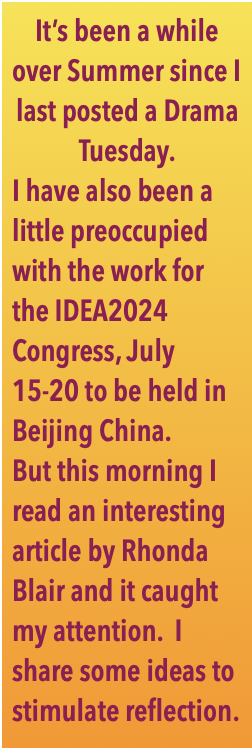Drama Tuesday - Understanding what we do in drama lessons
/with a little help from emerging cognitive science.
Often as drama teachers we work from an intuitively felt and understood knowledge about what we do and why it works.
I have cherry-picked some ideas from a just published article by Rhonda Blair (2024) about the underlying processes of thought and action in the drama classroom.
Stanislavsky’s work in his final phase in the 1930s, his“last words”,if you will, is known as Active Analysis
Active Analysis…requires actors to “discover the underlying structures of actions and counteractions in a play before memorising dialogue. Analysis is ‘active’ because cast members examine the play ‘on their feet’ through improvisations that test their understanding of how characters on the page relate to each other and confront each other in performance. The technique encourages deep communication between partners and spontaneity; it also fosters simultaneous activation of mind, body, and heart, which Stanislavsky sees as necessary in performance” (Carnicke 2009, 212). The actors read the play, get up and improvise scenes, return to the text to see what has been missed, then improvise again and again until the improvisation captures it, at which point the text is memorised.
Stanislavsky’s work intuitively foreshadows what we now know about the emerging field of cognitive science.
Cognitive sciences support what theatre practitioners intuitively know: we are holistic beings, inextricable from our environments, which include each other.
In line with Active Analysis, we must stop imagining the body, feeling, thought, and action as being separate "containers" of aspects of ourselves: “Bodies are better conceived as processes, practices, and networks of relations…”
The argument in Blair’s article goes beyond this simple analysis and I commend the whole article to you.
Amongst the complex ideas about cognition and human experience, the work on “4E” cognition caught my attention for its resonance to my own practice.
Bodies and action are central in all of this, just as they are in Stanislavsky’s thinking.
This means creating an "authentic" character, following Stanislavsky, is an exploration, a process.
Bodies are shaped and affected by their encounters with each other. The key to who we are "is not in our heads or in our genes, but out there in the world" (8); we are "precarious autonomous systems" that make the world by coupling with our environment and each other (17).
This is what is going on with Active Analysis - engaging the text with others, entering the space, exploring, reengaging, and examining what’s happened in order to move ahead together. The actors read the play “today” and then get it on its feet “tomorrow”. As Stanislavsky writes, “What can we rehearse? A great deal. A character comes in, greets everybody, sits down, tells of events that have just taken place, expresses a series of thoughts. Everyone can act this guided by their own life experience. So, let them act. And so, we break the whole play, episode by episode, into physical actions. When this is done exactly, correctly, so that it feels true and it inspires our belief in what is happening on stage, then we can say that the line of the life of the human body has been created” (SS IX 1999:655, in Carnicke 2009, 194).
This then gives us clues about how we should/could think about the process we call rehearsing. More importantly, there are direct implications for the sort of drama teaching that is valuable.







